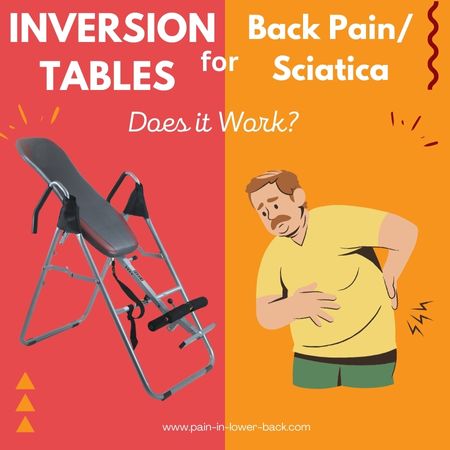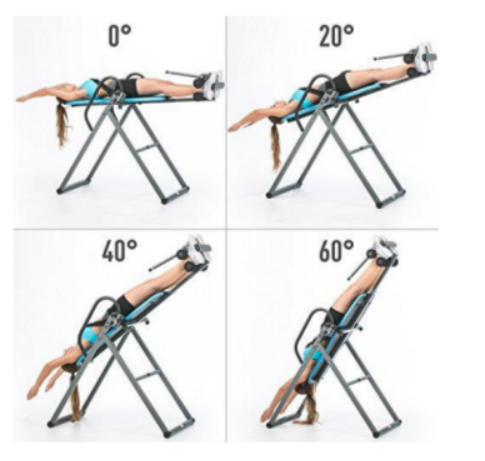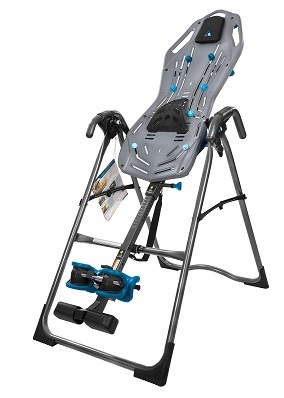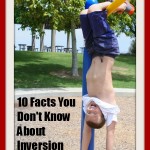While not enough research is being done on inversion tables for back pain and sciatica, many people are willing to try anything to relieve their aches and pains, and inversion tables are growing in popularity every year.
Inversion tables allow you to hang upside down (like a bat) while using gravity to decompress your spine and relieve your pain.
But before you go flipping your world around, you might be wondering if inversion tables are just a gimmick or if they can really help reduce your pain.

In this blog post, we’re going to take a closer look at the science behind inversion tables, analyze what the people are saying, and see if this is the real deal or just a waste of your money.
Overview
Inversion Table for Back Pain & Sciatica – What Does the Research Say?
Inversion therapy has been around for over 2,000 years, ever since Hippocrates strapped his patients to a ladder with ropes and hoisted them in the air to help relieve back pain and other ailments.

While there is still little research about inversion therapy and its benefits, there are a few studies that we can take a look at.
One recent study performed at the prestigious Newcastle University in England studied two groups of sciatica patients with herniated discs and pain so severe they had already been scheduled for surgery.
Both groups received physical therapy, but only one added regular inversion therapy to their routine.
At the end of the four-week study, 22% of those in the control group without inversion therapy recovered enough to cancel their surgery.
But, in the group that had inversion therapy treatments – 70/.5% were less likely to require surgery!
As for how quickly this works, the Noss study found EMG activity (an indicator of muscle pain) was reduced by 35% within the first 10 seconds of inversion and also found that it increases the spinal length.
This study has proven that only 10 minutes of full inversion can separate the spine vertebrae significantly, which help to heal bulging, slipped, and herniated discs.
And these are only some of the studies.
How Does Inversion Therapy Work?
Simply put, an inversion table takes the load off your back.
It’s a gentle, passive way to target pain at the source and care for all weight-bearing joints.
An inversion traction table is an adjustable platform that allows positioning in an upright or inverted position in order to allow the effects of gravity to meet requirements to cure the disorders related to the spine
Here are the results:
1. Immediate pain relief by relieving pressure – according to research, inverting at a 60-degree angle increases the space between the vertebrae. This can stop your pain immediately.
If you suffer from a bulging or herniated disc, the pain you feel is caused by pressure on the nerves around the discs. If you relieve the pressure, the pain stops. It’s simple as that.
Here’s one testimonial found on the Spine-Health.com forum:
I am 72 years old. My back pain was primarily in the morning upon arising…Pilates, yoga and toe touches help somewhat in stretching out those muscles. But, when I started using my Teeter Inversion Table, the difference was like night and day. After the first usage, I could stand and walk straight upright and the effect would last until the next day…I’ve found that if I do NOT use the inversion table for three or four days that my distorted walk and back pain tends to come back. So, I use the inversion table at least once and sometimes twice per day to keep my body more limber.
👉 Inversion therapy is one of the best sciatica home treatments.
2. Long-term and possible complete cure – this is achieved by rehydrating of the discs. When you give your discs this “break” from gravity, it allows for the moisture to be absorbed into the soft tissue of the discs, allowing for nutrients to absorb better and thus promoting the natural healing of a bulging, slipped, or herniated disc in your spine.
But you won’t achieve that in one session, give it a few weeks and maybe you could cancel your back surgery. Many people have.
3. Realigning of the spine – the decompression of the spine allows the spine misalignment to “fall” back into place.
Here’s one testimonial from a Reddit community:
I just got one in Dec. It has helped me immensely. I have degenerative disc , pinched nerves ,arthritis and old ruptured disc. I have been using it twice a day for 5-10 minutes at a time.
4. Relaxing tensed muscles – when you invert, the muscles are gently stretched, circulation increases and the tensed muscles finally get the real rest they need to heal.
How to Use Inversion for Back Pain?

Inverting is a form of exercise or a stretch, so you have to know what you’re doing to prevent damage and injury to your back.
Inverting starts with a very low angle at first (20 – 30 degrees), and many times you won’t even have to increase the angle to achieve good results.
Modern inversion tables are comfortable padded seats. Getting started with inverting has never been easier.
You just:
1 – Sit down
2 – Snap the ankle pads and seatbelt snugly in place
3 – Lean back
As you lean back, the chair automatically converts to a flat table. Gravity and your own body weight combine to gently stretch your back.
And that’s when the magic happens.
Space between compacted vertebrae increases. Pressure on spinal discs is relieved. Bulging and herniated discs begin to heal – and even slip back into their normal position.
Nonetheless, consult with your physical therapist or chiropractor before you start inverting at home.
According to the leading inversion table manufacturer – Teeter Hangups – beginners should start with only 1-2 minutes per session and advance only as they feel comfortable.
You could feel soreness at the beginning, just like with “normal” stretches that you do. Just reduce the angle or the duration and move more gradually with the exercises.
Here’s a helpful video demonstration showing how to adjust and use an inversion table:
Inversion Table Risks/Side Effects
The most dangerous aspect of an inversion table is the danger of falling off of it. A fall can cause a spinal cord injury. However, this can be prevented by choosing a high-quality and safe inversion table from a well-known and experienced brand (such as Teeter Inversion Tables) – and using it correctly.
Also, If you suffer from any of these conditions, you should check with your doctor before trying an inversion table:
Middle ear infection, Conjunctivitis, Recent stroke or transient ischemic attack, Extreme obesity, High blood pressure, Bone weakness (osteoporosis), Pregnancy, Hypertension, Recent or unhealed fractures, Hiatal hernia, Heart or circulatory disorders, Medullary pins, Ventral hernia, Spinal injury, Surgically implanted orthopedic supports, Glaucoma, Cerebral sclerosis, Use of anticoagulants (including high doses of aspirin), Retinal detachment, Acutely swollen joints.
Where and How to Buy an Inversion Table
Inversion tables can be divided into two basic categories:
- Manual (controlled by your own body weight and gravity)
- Automatic units (which have a remote control that allows you to invert at the push of a button).
Most gravity tables can be set at any angle through a specified range, while others will only rest at pre-set angles, such as 20, 30, and 60 degrees.

You should choose a table that fits your body: compare the weight limits on each table to choose one within your weight range.
Most tables cost between $200 and $600. If you are looking for the highest quality, I only recommend either the Teeter Inversion Tables or the lower-cost Innova Inversion Tables.
To your health and happiness
Meital
P.S
Do you know why gorgeous actress Eva Mendez has an inversion table at home? And why author Dan Brown has once too? It’s not because they have back pain…
You’ll be amazed by the other incredible benefits of inversion therapy
Studies
Study of Inversion Traction Therapy
Nosse LJ. Inverted spinal traction. Arch Phys Med Rehabil. 1978 Aug;59(8):367-70. PMID: 687049.
Kane MD, Karl RD, Swain JH. Effects of Gravity-Facilitated Traction on lntervertebral Dimensions of the Lumbar Spine*. J Orthop Sports Phys Ther. 1985;6(5):281-8.


I would try back traction along with infrared heat pad every day for at least an hour. I know of a lot of people avoiding surgery through using back traction
I Have Bulging Disc In L5/L4 Area, Impinged Feeling On Lower Left Back Area A Sort Of Tightness, Severe Sciatic Nerve Pain Running Left Leg ,Have An Inversion Table, What Angle Should I Use At I Can Adjust All The Way To Head First Down, And For How Long, 10- 15 Mins?
To my knowledge, you can start gradually at a low angle (30) and work you way up while listening to your body and watching how you feel. Yes, 10-15 minutes is fine.
Well 🙂
Thanks for your kind reply.
Hi,
I came up with Infrared Heating PAD here and now confused which one to go for? Inversion Table or Heating PAD? Which is safer for elderly people?
Hi:)
An infrared heating pad is probably safer in general.
My mother and my sister are using inversion table
I received a response from them that it’s really very good. They almost have improved the situation back pain after 6 months
I am suffering from a herniated disc in the lumbar region of the spine. I have been doing physical therapy which was prescribed by a Neurologist for 3-4 weeks now. I researched what surgery would be best for me. I understood that microdiscectomy is the best option till I stumbled across your webpage. Waiting on your comments.
Keino,
If I were you I would try a few natural treatments before I go to surgery. I would try back traction along with infrared heat pad every day for at least an hour. I know of a lot of people avoiding surgery through using back traction. You can see other traction options other than inverting here: https://pain-in-lower-back.com/traction-for-lower-back-pain/